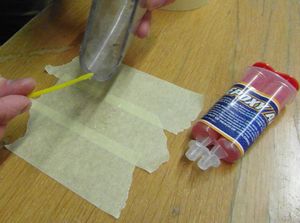Material:Epoxy Resin

Epoxy resin (Epoxidharz) is usually a two-part mixture that is - once dried - incredibly strong; in fact, it's one of the strongest glues existing. The name "epoxy" originates from the functional group of epoxides which consist of an oxygen atom bound to two carbon atoms. This group is relatively reactive and can form polymeres with various substances.

Epoxy Glue
| MaterialInfoBox Epoxy Glue | |
|---|---|

| |
| Synonyms: | epoxy adhesive; DE: Epoxidkleber, "Zweikomponentenkleber" |
| Suggested Tools: | |
| Contains: | polyepoxides |
Overview
There are different types of epoxy glues, the one commonly available in hardware stores is a one-to-one mixture glue. That means that for the perfect mix - and therefore for the strongest result you need to use 50 % of each part. The resin is often sold in a two-flute syringe and when squeezing out glue you automatically squeeze out both parts in equal amounts, so there is no difficulty with getting the mixture right. Besides its incredible strength epoxy resin also tends not to expand or shrink a lot while drying and has good thermal properties.
Be aware when using fast curing epoxy in larger quantities in one spot (best part of a syringe) that there is a major heat buildup (well above 100 °C). This can cause your object to melt or deform in some way. If you want to fill up an empty space with epoxy (e.g. a mold) use casting resin instead.
Usage
- make sure the surfaces that you want to glue together are completely free of dust and grease. If one or more components have smooth surfaces, scratch or sand them to a rough finish, otherwise the resin will not bond.
- take a piece of masking tape, tape it down to your workbench and squeeze the epoxy resin onto the tape. Be careful about the amount of resin you are using as most times you don't need much more than a few drops.
- mix the two parts with a piece of scrap wood or a chopstick VERY well together - the better you mix it, the stronger your bond will be.
- put the epoxy resin on the corresponding surfaces and clamp the pieces together (the clamping force is irrelevant, this is only for alignment). Be aware of the fact that you only have about 5 minutes to work with the epoxy as it starts to dry immediately after mixing.
- wait for at least 15-20 minutes.
- remove the piece of tape with the dried excesses of the resin and throw it in the bin.
- enjoy your masterpiece.
Epoxy Casting Resin
For filling up larger volumes with epoxy, such as molds, use casting epoxy resin. In contrast to the epoxy glue it has a longer curing time (multiple hours), different viscosity and is not always mixed in a 1:1 ratio. The properties of epoxy casting resins vary quite a bit and should be checked before using one on your project. Some examples:
- working/curing time
- can be multiple minutes to hours and for maximum strength even days
- viscosity
- an important aspect for your use case - some resins are like water and will flow through the tiniest cracks and holes (desired or not) while others are more similar to honey.
- shrink
- all resins, whether epoxy or any other chemical basis, tend to change in volume while hardening. ** this is especially important for making molds so look for a resin with a low shrink ratio (<1 % should be fine for most uses).
- cured material properties
- hardness, temperature resistance, color (most epoxies are not crystal clear)
Tips
- when mixing the two components be sure they are mixed very well!
- rule of thumb: if you think they are mixed nicely – keep on stirring for another 1-2 minutes
- wear gloves – epoxides are quite unhealthy!
- don't trust your mold to keep the epoxy in, but put it in another box or plastic bag – there is nothing [citation needed] worse than epoxy resin on the floor!
- pop bubbles with a hot air gun as they reach the surface!
- you can add color by mixing in various ingredients - be aware that liquid dyes may "bleed" into a porous material like wood while powders won't! [1]
Epoxy Lamination Resin
Epoxy resins are also used for lamination of glass or carbon fibre. Laminating is a science on its own therefore is is highly recommended to read into the topic if you plan on laminating with epoxies; especially if the part needs to be mechanically durable.
Will be extended once someone has experimented with this.
Talk to Patrick